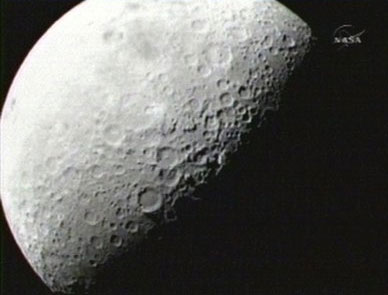Nasa: The 'bombing' Moon successfully
NASA said the " bombing " of missiles and satellites on the Moon on October 9 was successful, producing enough dust to allow scientists to determine if there is water on the Moon.
On the morning of October 9, NASA stabbed the Centaur rocket and satellite. Touch and observe the Moon Crater (LCROSS) on the Moon's surface, in a mission costing $ 79 million. NASA gave live broadcast of LCROSS when it crashed near the south pole of the Moon.
Minutes before the impact, the satellite led a rocket to hit the surface of the Moon first to create enough dust for LCROSS to look for whether there is water in the Moon's soil.

The first image of the Moon by LCROSS October 9 was announced by NASA.
The upper floor of the rocket crashed into the Moon just after 7:30 am (US time) and the satellite plunged four minutes later with the cameras shooting the first collision.
But a ' dusty rain ' incident as everyone expected did not happen. The screen is noisy and there are no photos of the collision yet. No columns of dust and smoke as high as 10km rise as one would expect. Most NASA photos announced at a press conference followed by the crash.
However, NASA scientists are still happy and call the ' bombing ' case a success. ' We already have the necessary data to finally be able to answer the question we have asked ,' said Anthony Colaprete, principal investigator for the LCROSS mission.
However, the LCROSS project manager Dan Andrews said it would take some time to analyze all the satellite data obtained and make the conclusion whether water exists on the Moon or not. But he is also optimistic that ' satellite exploration has performed spectacularly '.
- How is the moon almost bombed?
- NASA launches the spacecraft to explore the Moon's atmosphere
- NASA revealed the time of the first immigration settlement on the Moon
- Hearing that Russia will go to the Moon to check, NASA rushes to prepare to send people to the Moon again
- NASA returned to the moon
- NASA announced 8,400 photos of the process of exploring the Moon
- Latest photos of the moon
- NASA successfully launched the new moon rocket
- NASA launched the Lunar Travel Law
- NASA built landing zones for the spacecraft near the moon
- NASA uses lasers to transmit data to a moon satellite
- NASA 'moon' twins
 Van Allen's belt and evidence that the Apollo 11 mission to the Moon was myth
Van Allen's belt and evidence that the Apollo 11 mission to the Moon was myth The levels of civilization in the universe (Kardashev scale)
The levels of civilization in the universe (Kardashev scale) Today Mars, the sun and the Earth are aligned
Today Mars, the sun and the Earth are aligned The Amazon owner announced a secret plan to build a space base for thousands of people
The Amazon owner announced a secret plan to build a space base for thousands of people What would a day on the Moon be like for astronauts?
What would a day on the Moon be like for astronauts?  First photo of Mars' strangely shaped moon
First photo of Mars' strangely shaped moon  The biggest supermoon of the year is about to light up the world's skies
The biggest supermoon of the year is about to light up the world's skies  New research shows that Earth has a new 'Moon'
New research shows that Earth has a new 'Moon'  James Webb Telescope Discovers Rare Scene From Saturn's Moon
James Webb Telescope Discovers Rare Scene From Saturn's Moon  Shock Detected on the Dark Side of the Moon: Structure Identical to Earth!
Shock Detected on the Dark Side of the Moon: Structure Identical to Earth! 